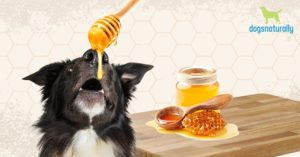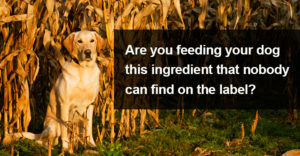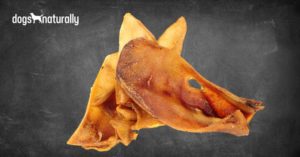Feeding your dog a fresh, whole food, raw diet is the best way to ensure he gets all the essential nutrients. But when feeding commercial foods, those nutrients diminish based on the type of processing used.
First, here’s how different foods are made. And then we’ll take a look at how the processing itself can be harmful …
How Is Dry Dog Food Made?
Kibble is an ultra-processed food, with several high temperature steps.
- Meat rendering: This is usually done by meat processors. Fats are broken down (rendered) by heat or enzymatic – and solvent – extraction. Then the resulting “pink slime” is sent to pet food companies.
- Grinding And Pre-Cooking Meat: Some companies may receive the meat in a solid state so meat products are ground. Then it’s cooked in a continuous cooker with live steam.
- Added Vegetables And Fruit: Ingredients like tomato pomace, pea protein and beet pulp are by-products of the food industry. So they’ve already been processed when used for other food products. Other unpalatable foods and leftovers destined for dog food are also processed/cooked and ground. Then they’re blended with the rendered or ground meat products, grains and starches. Vitamins and minerals are added to replace those destroyed by heating.
- Thickening The Dog Food: Dry foods are heated again to thicken starches in the mixture.
- Extrusion: This is the final stage of processing for dry dog food. The mixture is extruded under high pressure and heat to create biscuits, kibbles, meatballs, patties, pellets or slices.
How is Canned Dog Food Made?
Canned dog foods are highly processed foods. They’re made in an industrial-size pressure cooker with temperatures as high as 275F. The more carbohydrate in the food, the higher the temperature. And the foods are heated twice during processing.
The resulting foods are sterile. That means there aren’t any bacteria, mold or viruses within the sealed cans. But here are some damaging effects of heat processing:
- Destroys B vitamins and vitamin C.
- Oxidizes fragile fatty acids like EPA and DHA.
- Inactivates enzymes that aid in digestion
- Denatures proteins, which can cause allergies and sensitivities
Canning is a process that allows dog food formulators to become creative – and economical – with the ingredients. Your dog’s beef stew or roast chicken dinner may in fact be mostly pea protein isolate and tapioca starch.
RELATED: What you need to know about canned dog food …
How Is Dehydrated Dog Food Made?
Dehydrated or air dried dog foods are much less processed than kibble or canned foods, but they all use heat. These foods may also be described as “gently cooked” or “lightly baked.” The food may be cooked or dried at low temperatures for an extended period of time.
Most dehydrated, baked, and cooked foods undergo temperatures between 118 and 200F. But temperatures as low as 110F can still inactivate enzymes and denature proteins. And even moderate heat can break down B vitamins and vitamin C, and may cause fragile fatty acids like EPA and DHA to oxidize.
How Is Freeze-Dried Dog Food Made?
A vacuum dryer allows the frozen water in dog food to effervesce. It goes directly from a solid to a gas, without passing through a liquid state, if the air pressure is low enough. Because freeze-dried food is made without heat, there’s no damagie to the natural enzymes in food that aid in digestion.
Freeze drying also allows for better palatability, texture and taste.They’re as convenient as kibble … but have the same nutrients as a raw diet. The main drawback to freeze-dried foods is they can be expensive.
RELATED: The pros and cons of freeze-dried dog food …
How Is Frozen Raw Dog Food Made?
Frozen raw dog foods are minimally processed. There’s a mixer, a packaging machine, and a freezer. There’s no loss of nutrients during processing so your dog will get all of the nutrition from the original food ingredients.
The exception is high pressure pasteurization (HPP) of raw foods to eliminate pathogenic bacteria. Laboratory analysis shows there is some, but not much, nutrient loss from the HPP process. While some raw feeders prefer to avoid HPP foods, claiming they’re not truly raw … the process does reduce costly recalls for the manufacturers. And if your vet is anti-raw feeding, she may be more comfortable with HPP foods.
RELATED: The good and the bad of HPP dog food …
How Processing Damages Health
In people, study after study shows ill health effects from a diet of processed food. This list is just a sampling …
- In a 2020 Australian review, 37 of 43 studies found ultra processed food (UPF) was associated with increased overweight, obesity and cardio-metabolic risks, cancer, type-2 diabetes and cardiovascular diseases; irritable bowel syndrome, depression and frailty conditions; and all-cause mortality.
- The same review noted cardio-metabolic risks and asthma among children and adolescents.
- None of the studies reported an association between UPF and beneficial health outcomes.
- A 2009 project by ICARE examined heat treatment of foods. Infants fed processed foods (formula) showed increased oxidative stress and lower insulin sensitivity … and effects were usually long lasting.
- A 2016 study showed that processed foods contain polycyclic aromatic hydrocarbons (PAHs) from heating, drying and baking. PAHs are known environmental carcinogens.
- A 2017 review linked ultra-processed food to a higher risk of metabolic syndrome, hgher fasting glucose, cardiovascular disease, coronary heart, and cerebrovascular diseases.
Research In Dogs
All of these harmful effects in humans likely affect dogs eating highly processed diets as well. Leaving aside the ill effects of poor quality ingredients and harmful additives in many commercial diets … there’s research showing the processing itself can damage health.
Carcinogens From Processing
Research shows high heat dog food processing creates cancer-causing substances like …
- Heterocyclic amines – formed by heating meat and fish
- Acrylomides – formed by heating vegetables and grains
- PBDEs – flame retardants created during heat processing
Gut Health
A study at University of Helsinki found that puppies fed non-processed, meat-based diets had lower tendency to develop IBD later in life, while ultra-processed carbohydrate-based diets increased IBD incidence.
In 2021, another study transitioned 4,978 healthy dogs to a mildly-cooked diet from extruded kibble. After 4 weeks, there were significant changes in the dogs’ microbiome profile, with increased abundance of 70 bacterial species.
Digestibility
A 2014 study by The Nutro Company noted, “the processing of commercial pet food can impact digestibility, nutrient bioavailability, and safety.”
This excerpt from a 2020 Bulgarian review of raw diets for pets observed …
“There is literary data for nearly 4 decades proving that the extrusion reduces food digestibility (Kendall et al., 1982; Björck et al. 1983). Hamper et al. (2015) also found better digestibility of the nutrients of BARF food, compared to canned foods with very similar nutritional composition.”
Choose Less Processed Dog Food
Dogs thrive on whole food, raw meat-based, minimally processed diets. And the research shows that it’s not just low quality ingredients that cause harmful effects … but the way the food is made also creates health hazards for your dog.
It’s safest to feed your dog the least processed food you can afford. But if you do feed kibble, try to add some fresh foods to your dog’s dish. Just that small change can improve his health considerably.
Here’s how to make kibble more nutritious …
References
Elizabeth L, Machado P, Zinöcker M, Baker P, Lawrence M. Ultra-Processed Foods and Health Outcomes: A Narrative Review. Nutrients. 2020; 12(7):1955.
Poti, J.M., Braga, B. & Qin, B. Ultra-processed Food Intake and Obesity: What Really Matters for Health—Processing or Nutrient Content?. Curr Obes Rep 6, 420–431 (2017).
Turesky, RJ, et al. Biomonitoring the Cooked Meat Carcinogen 2-Amino-1-methy-6-phenylimidazo [4,5-b]pyridine in Canine Fur. J Agric Food Chem. Aug. 2012
Cotillon, Christophe. Impeding neo-formed Contaminant Accumulation to Reduce their health Effects. ICARE Consortium. July 2006. 516415 973439 ICARE_516415.pdf
Srour, Bernard, et al. Ultra-processed food intake and risk of cardiovascular disease: prospective cohort study (NutriNet-Santé). BMJ. May 2019.
Tanprasertsuk J, et al. Heterogeneity of gut microbial responses in healthy household dogs transitioning from an extruded to a mildly cooked diet. PeerJ. 2021 June.
Neshovska, Hristina. The Raw Dog Food – Advantages And Disadvantages. Faculty of Veterinary Medicine, Bulgaria. 2020.
Hemida M, Vuori KA, Moore R, Anturaniemi J, Hielm-Björkman A. Early Life Modifiable Exposures and Their Association With Owner Reported Inflammatory Bowel Disease Symptoms in Adult Dogs. Front Vet Sci. 2021 Feb 1;8:552350.
Buff PR, Carter RA, Bauer JE, Kersey JH. Natural pet food: a review of natural diets and their impact on canine and feline physiology. J Anim Sci. 2014 Sep;92(9):3781-91.












